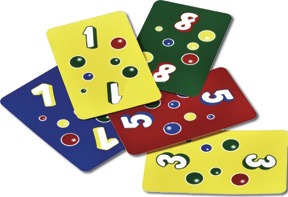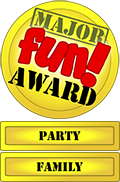 Shake ‘n Take is a wonderfully silly game about aliens that gets a lot of laughs and a lot of tension out of a very simple action. At its heart, Shake ‘n Take is a race to see who can circle all the items on a plastic card. Throw in a few complications and before you can say Na-Nu Na-Nu everyone is preparing to pounce on the person with the dry-erase marker that looks like it escaped from Area 51.
Shake ‘n Take is a wonderfully silly game about aliens that gets a lot of laughs and a lot of tension out of a very simple action. At its heart, Shake ‘n Take is a race to see who can circle all the items on a plastic card. Throw in a few complications and before you can say Na-Nu Na-Nu everyone is preparing to pounce on the person with the dry-erase marker that looks like it escaped from Area 51.
Dry erase technology has been under-utilized in the game industry. Now, maybe there are sound, environmentally conscientious reasons why dry erase markers are used less than paper and golf-pencils when it comes to score keeping, doodling, and lists. Maybe. But it just seems to me like a tremendous waste when games include pads of paper and columns of wooden pencils that are destined to be used once and then thrown away (you know you throw those pencils away the first chance you get). Dry erase as an oeuvre has its limits but many games could be adapted very well to a single white-board and a few markers. I’m just sayin’.
Shake ‘n Take puts the technology to great use and it is so fun that you hardly realize how intoxicating the fumes from the markers can be in an enclosed room. Out of the Box Games has also employed dry-erase markers in their party-game Backseat Drawing. That game requires players to follow directions and draw simple shapes. Shake n Take only requires that players can make circles.
Here’s what you get with the game: 2 markers; 2 marker holders in the shape of long green aliens; 10 large plastic cards decorated with an array of 70 small aliens; 2 dice; 2 alien shakers; 2 erasers. Each player gets one of the cards. In games of 5 or fewer players, only one marker (in its alien holder) one shaker and one die are used. In games of 6 or more, both of the markers, shakers, and dice are utilized.
The goal: circle all 70 aliens on your card. Each alien must be circled individually. It’s crowded on the card so be careful—a circle around one alien may not touch another. The aliens come in 5 distinct shapes (circle, square, star, heart and triangle). This matches the shapes on the die. Roll the die and start circling aliens of that shape. You may re-roll at any time. While you are circling, the person to your right is frantically rattling the alien shaker. This is a clear plastic egg with a green die in it. One side of the shaker die has the picture of an alien. When the alien comes up, that player snatches the dry erase pen out of your hand, rolls the shape die, and starts circling aliens.
 That’s right. Snatches the pen from your hand. Nothing polite. Nothing subtle. You don’t even get to finish circling an alien. ZZWOOOP!! Like when the mother-ship tractor beamed you out of your bed for a round of hide the probe.
That’s right. Snatches the pen from your hand. Nothing polite. Nothing subtle. You don’t even get to finish circling an alien. ZZWOOOP!! Like when the mother-ship tractor beamed you out of your bed for a round of hide the probe.
The game is loud and fast and you leave with lots of marker streaks on your hands, but phone home is it fun. With six people we had 2 markers and shakers going at once. There is very little down-time and those who aren’t circling aliens or obsessively agitating the shaker are making a huge racket to distract those who are. Snatching the marker is great: incredibly satisfying and frustrating all at the same time.
Another interesting feature regards the plastic cards. They are reversible. On one side, there are aliens that closely resemble the five basic shapes. On the reverse side, there are simply shapes. This allows for a wider range of players as younger children won’t find the cartoonish alien shapes so distracting. Even with older, more experienced players, the side with the simple geometric shapes was plenty challenging and plenty of fun. Major Fun– regardless of your planet of origin.
Shake ‘n Take concept by Keith Meyers. Illustration and graphics by John Kovalic and Cathleen Quinn-Kinney. © 2010 Out of the Box Publishing.






 Blitz (German for lightning) is the operative word. Each player has a “Blitz” pile of 10 cards. The goal is to get rid of these 10 cards by playing them on piles of cards that sprout up in the middle of the table. Players may start a pile in the middle of the table, the “Dutch” piles, with the number 1. Once a “Dutch” pile is started, the other players may play their cards sequentially on that pile (2 goes on a 1, 3 goes on a 2, etc…) It is important to remember that the goal is to get rid of the “Blitz” pile. The first player to play all the cards of this “Blitz” pile shouts BLITZ!! and the round stops. The other players count up how many cards are left in their Blitz pile and multiply by two. These are negative points. Cards played to the Dutch piles are sorted (each deck has a different picture on the back) and counted. These are positive points. Each round is scored and the game ends when a player reaches 100 points.
Blitz (German for lightning) is the operative word. Each player has a “Blitz” pile of 10 cards. The goal is to get rid of these 10 cards by playing them on piles of cards that sprout up in the middle of the table. Players may start a pile in the middle of the table, the “Dutch” piles, with the number 1. Once a “Dutch” pile is started, the other players may play their cards sequentially on that pile (2 goes on a 1, 3 goes on a 2, etc…) It is important to remember that the goal is to get rid of the “Blitz” pile. The first player to play all the cards of this “Blitz” pile shouts BLITZ!! and the round stops. The other players count up how many cards are left in their Blitz pile and multiply by two. These are negative points. Cards played to the Dutch piles are sorted (each deck has a different picture on the back) and counted. These are positive points. Each round is scored and the game ends when a player reaches 100 points. When the Major Fun tasters played the game, I sat out many of the rounds. Experience is a definite advantage in speed games, and sure enough, when I finally played a few hands I won easily. But the others learned quickly and once the learning curve smoothed out, we had several tense, exciting rounds. Brought back memories.
When the Major Fun tasters played the game, I sat out many of the rounds. Experience is a definite advantage in speed games, and sure enough, when I finally played a few hands I won easily. But the others learned quickly and once the learning curve smoothed out, we had several tense, exciting rounds. Brought back memories.